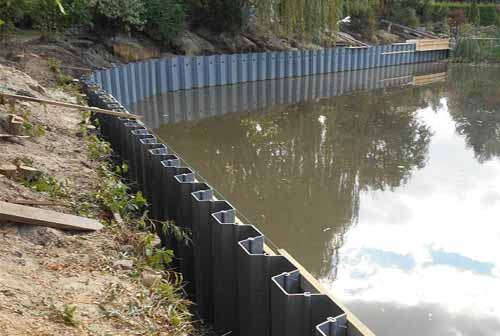
Composite sheet piling is a type of sheet piling that is made of fiberglass reinforced plastic (FRP) or other composite materials. Sheet piling is a construction technique that involves driving interlocking sheets of material into the ground to form a continuous barrier. Sheet piling is often used for retaining walls, seawalls, cofferdams, foundations, and other applications where a strong and durable wall is needed.
Composite sheet piling has several advantages over traditional materials such as steel, wood, or concrete. Some of these advantages are:
Corrosion resistance: Composite sheet piling does not rust, decay, or spall due to exposure to water, salt, chemicals, or biological agents. This reduces the maintenance costs and extends the service life of the wall.
Lightweight: Composite sheet piling is much lighter than steel or concrete, which reduces the transportation and handling costs and allows for easier installation. Composite sheet piling can also be driven with conventional equipment or even by hand in some cases.
Strength and stiffness: Composite sheet piling has high strength-to-weight and stiffness-to-weight ratios, which enable it to withstand high loads and stresses. Composite sheet piling can also be designed to have different properties depending on the direction of the load, which enhances its performance and versatility.
Environmental friendliness: Composite sheet piling has a lower environmental impact than steel or concrete, as it does not require mining, smelting, or curing processes. Composite sheet piling also does not leach harmful substances into the soil or water, and can be recycled or reused at the end of its life cycle.
How to install composite sheet piling
The installation of composite sheet piling depends on the site conditions, soil characteristics, design specifications, and equipment availability. However, some general steps are:
Prepare the site: Clear any debris or obstructions from the site and mark the alignment of the wall.
Drive the sheets: Use a pile driver, vibratory hammer, impact hammer, water jetting, or manual methods to drive the sheets into the ground along the marked alignment. Make sure to align the sheets properly and interlock them securely.
Install the accessories: Depending on the design requirements, install any accessories such as wales, caps, tie rods, anchors, or braces to reinforce the wall structure.
Backfill the wall: Fill the space behind the wall with suitable material such as soil, gravel, sand, or concrete to provide additional support and stability.
 +86 15303735673
+86 15303735673 Jessica@frpzs.com
Jessica@frpzs.com
 Technical Data
Technical Data











